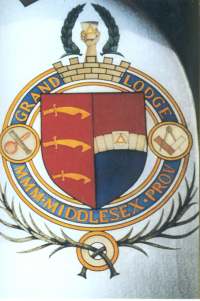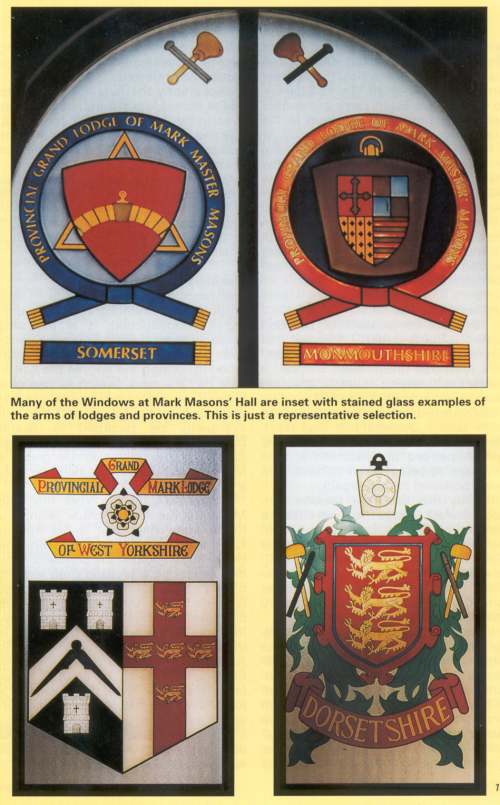
THE MARK DEGREE is 'one of the most
successful of the orders 'beyond the
Craft'. In England and Wales it is
regarded as a completely separate
order, because of the muddled compromise that created the United Grand
Lodge of England in 1813, and which in
effect alienated all the degrees outside
the Craft with the exception of the
Royal Arch. Throughout the rest of the
world, they retain the traditional connection with the Antients, in that it is
part of a structure within Masonry in
general. This is certainly the case in
Scotland (where it is administered by
Grand Chapter) and Ireland, and in the
USA (where it is administered within
the Royal Arch group) it is an integral
part of the York Rite.
Was it Dunckerley?
There is documented evidence that
masons 'made their mark' in Scotland
as far back as 1599; but there is no evidence of an attached ritual. It seems
more likely that certain masons were
just accorded a mark on initiation.
In England, the earliest mention is
almost certainly that in Royal Arch
Chapter of Friendship, at Portsmouth,
in 1769, when Thomas Dunckerley
made some brethren Mark Masons and
Mark Masters, each being given, or
choosing, a mark. By 1777, John
Knight (of the Moderns, but working an
Antient structure) was documenting it
in a rite that read: Entered Apprentice,
Fellow Craft, Mark Man or Foreman of
FCs, Master Mason, Mark Master, etc.
From then on, there were soon records
of the working of the degree in lodges
and chapters in England, Scotland and
Ireland.
Where did Dunckerley get his ritual
from? We don't know. Several masonic
historians, including Yasha Beresiner ,
have suggested the possibility that it
was actually invented by Dunckerley; a
theory that certainly fits all known
facts.
Whereas the premier (1717) Grand
Lodge insisted, for 70 years or so, that
'pure' Masonry consisted of only the
three degrees (and that did NOT
include the Royal Arch -see 'A Prag
matic Masonic History' in the December 1998 issue}, the Antients incorporated it into their degree structure.
Indeed, so tightly woven was it, that
minutes of many Antient lodges show
it was conferred in between the Fellow
Craft and Master Mason degrees, as
above.
Despite the protestations of the pre
mier Grand Lodge (Moderns), many of
their lodges worked the Antient degrees - especially Mark. So much so
that, to avoid this practice, the premier
Grand Lodge created Grand Chapter ,
so that lodges could carry out further
degrees without working them in the
Craft lodge.
After the Union of the two Grand
Lodges in 1813, the position of the
Mark was difficult, because the new
UGLE tried to ignore all the further
degrees apart from the Royal Arch.
However, by now the Mark was an
integral part of Masonry in Scotland,
Ireland and the USA. It was still being
worked in some English lodges, but
with increasing difficulty.
An Illegal Warrant
In 1851, six companions of the Bon
Accord Royal Arch Chapter of
Aberdeen, who were resident in London, obtained from their chapter a
warrant authorising them to meet in
London as a Mark lodge. Of course,
Bon Accord Aberdeen had no power to
issue such a document. It was reprimanded by Scotland's Grand Chapter
and suspended in 1855; but it took
umbrage at being taken to task, and
never bothered to meet again.
But by this time the London Bon
Accord Mark Lodge had advanced a
number of English brethren of note,
including Lord Leigh, Provincial Grand
Master for Warwickshire (1852-1905),
who was installed as Master of the
lodge in 1855. And as they were no
longer under Scottish jurisdiction, they
remained working.
In March 1856 an attempt was made
to bring the Mark degree under the
wing of the UGLE as a 'graceful addi-
tion to the Fellow Craft degree'. A reso-
lution was put down: 'That the Degree
of Mark Mason is not at variance with
Craft Masonry, and that it should be
added thereto, under proper regulations'. This was generally approved.
Certainly there were no arguments
against. However at the following
Quarterly Communication, in June, the
motion was rejected.
Apparently the lads at Bon Accord
and at other lodges were ready for this
eventuality, because on 23 June 1856,
a Grand Lodge of Mark Master Masons
was created with Lord Leigh as the first
Grand Master.
One of the first actions of the new
Grand Lodge, was to issue a Warrant
of Confirmation to the London Bon
Accord Lodge with no number and TI
or time immemorial status -which it
retains to this day.
The Mark Today
The Mark degree takes place in and
around King Solomon's Temple during its construction; it is the only
masonic order -apart from the Operatives -to deal with actual stonemason
working. During the degree the candidate has his mark (which he can pick
himself, or select from several put forward to him) approved, and this will
eventually be recorded in Grand
Lodge and written on his Grand Lodge
Certificate. He will also be given a
Mark token. A candidate need be only
a Master Mason.
In the USA, in the York Rite, the
Mark degree takes place within a
Royal Arch chapter; it is the first of
four degrees culminating with the
Holy Royal Arch. In Scotland, the
degree can be worked in Craft lodges,
or it can be taken in a Mark lodge
within a Royal Arch chapter -no-one
can take the Royal Arch without having been advanced in the Mark. This is
in accordance with the working of the
Antients; a procedure destroyed in
England with the Union of 1813. In Ireland, the Mark must be taken in a
Royal Arch chapter, and is a prerequisite to exaltation.
The Mark also encompasses the
degree of Royal Ark Mariner -which
we will deal with some other time.

| ![]() News Feed |
News Feed |  Subscribe News by Email
Subscribe News by Email